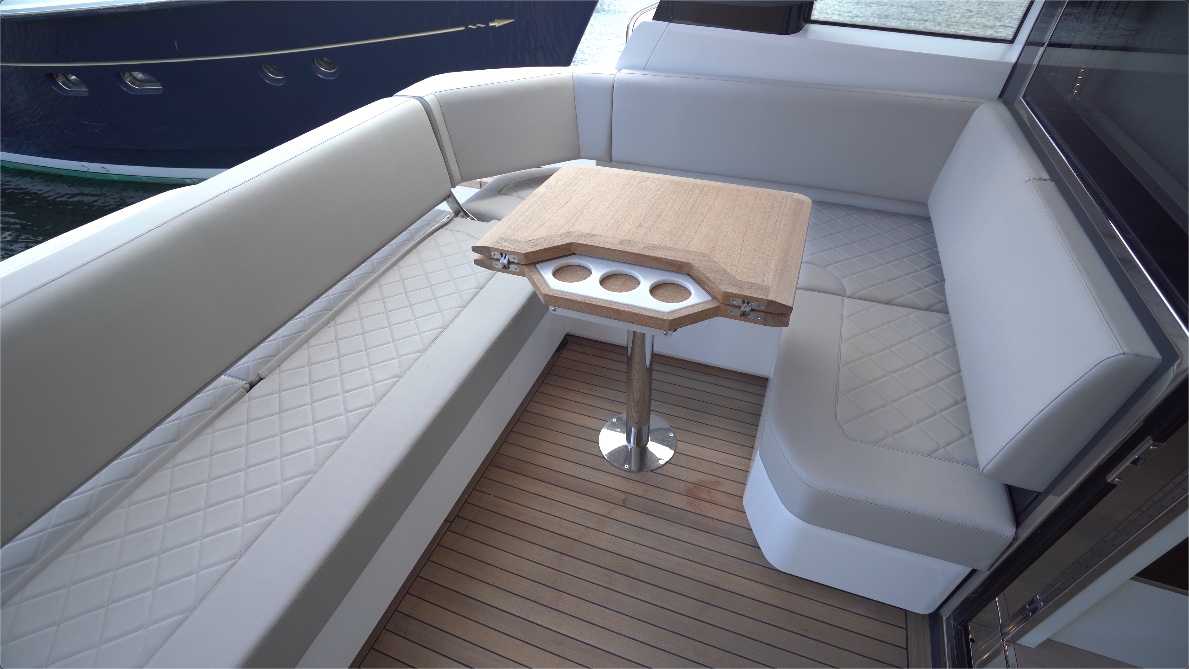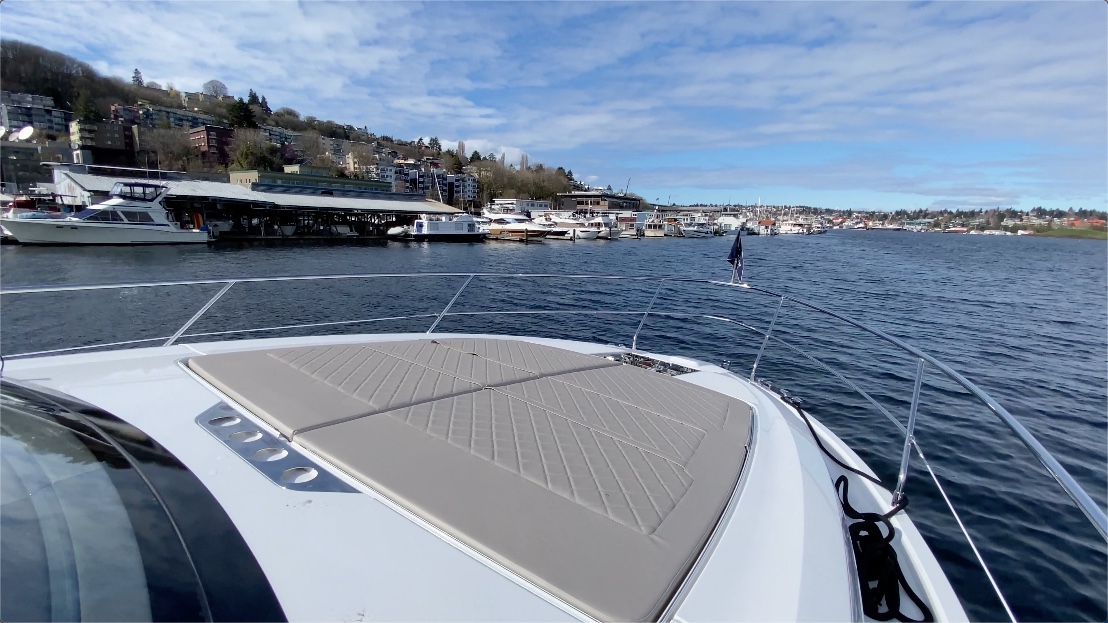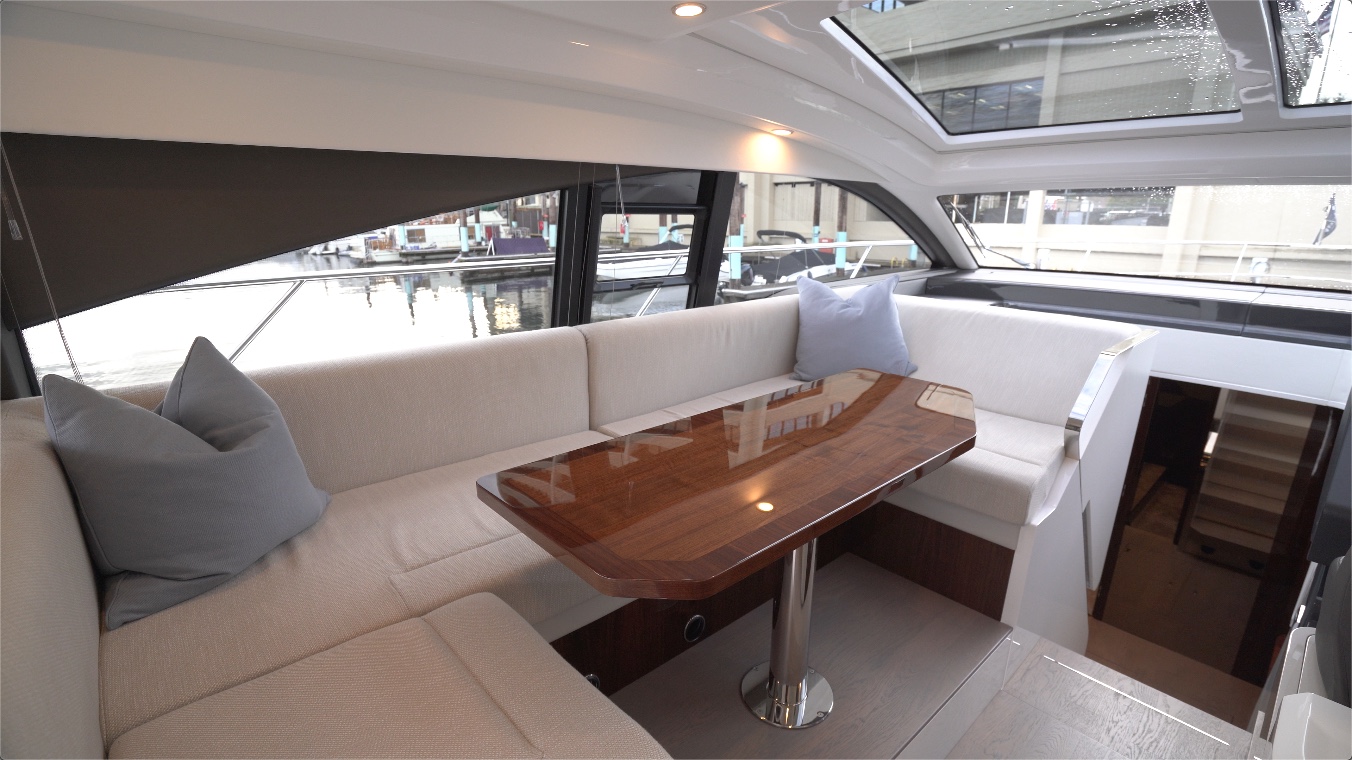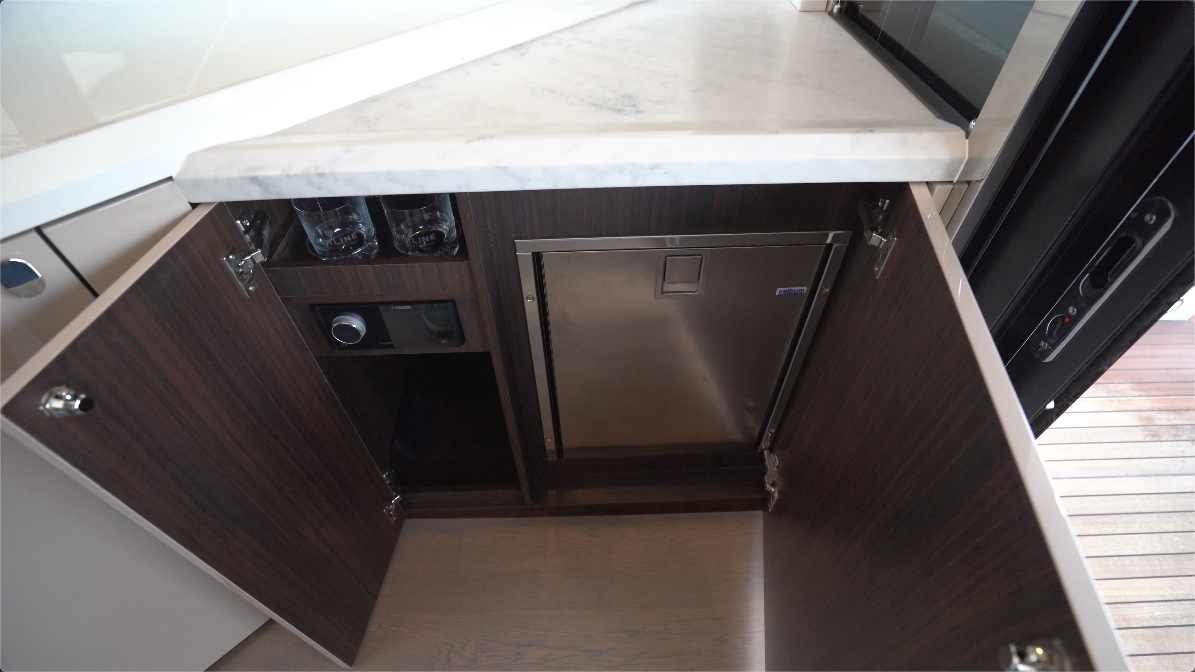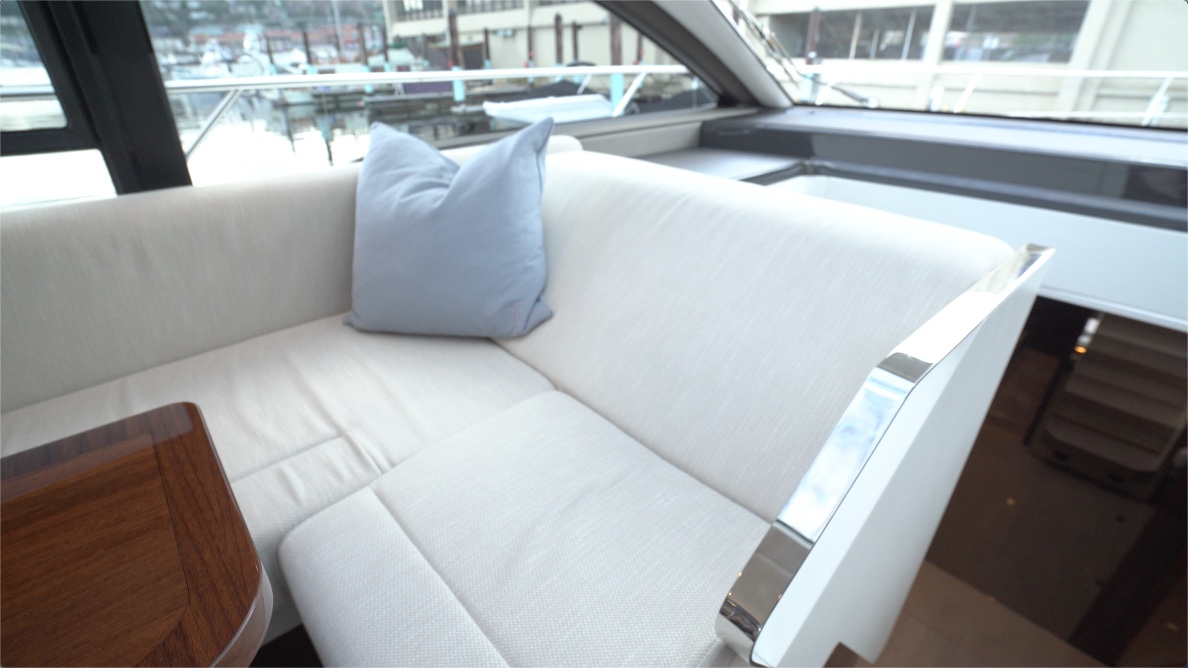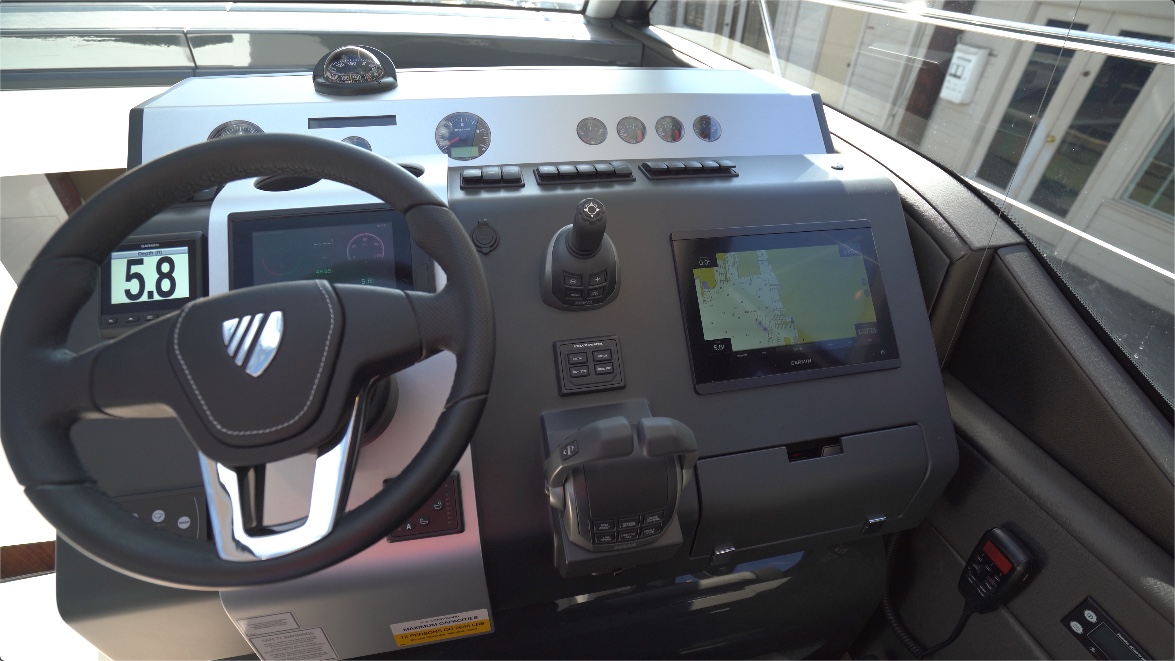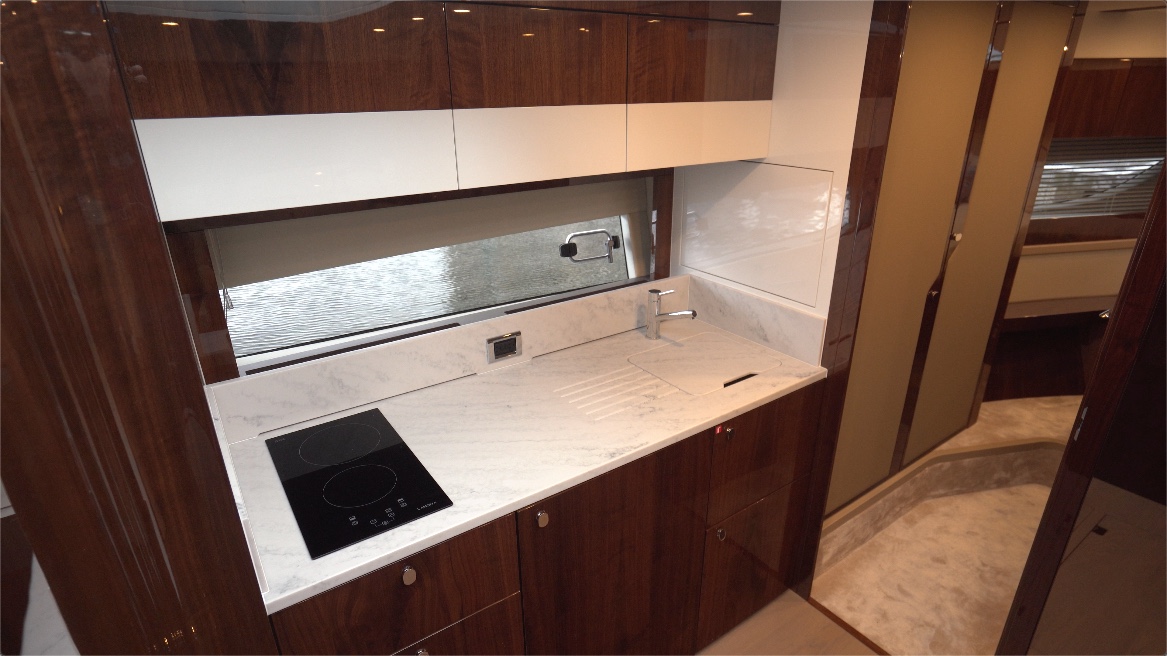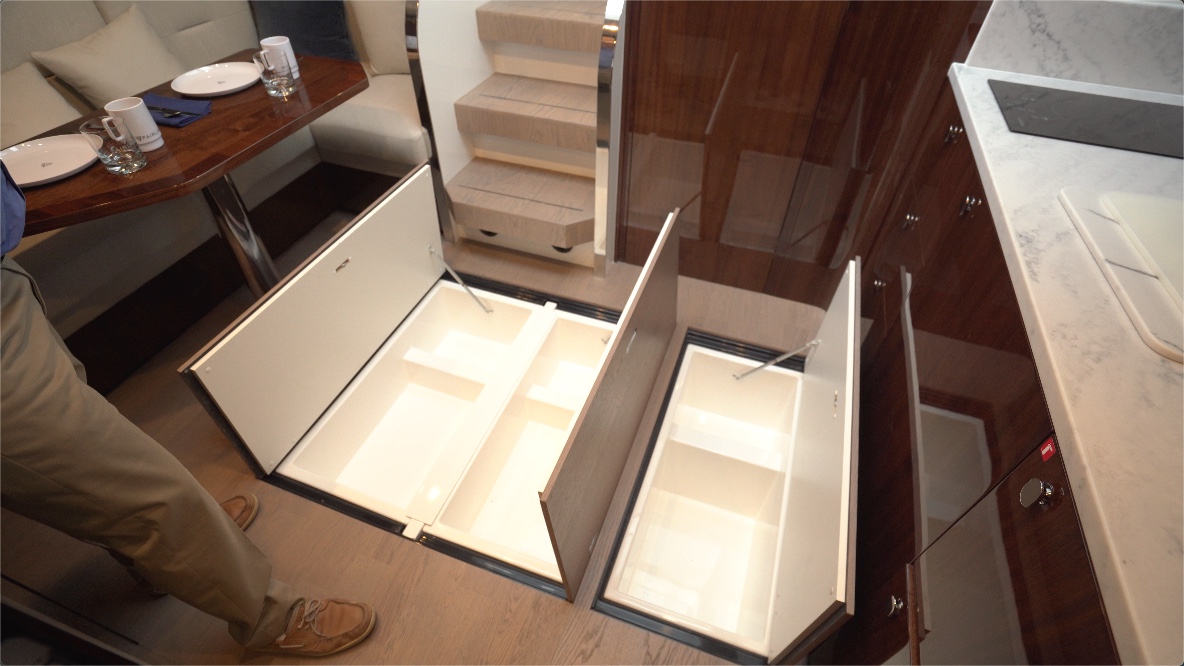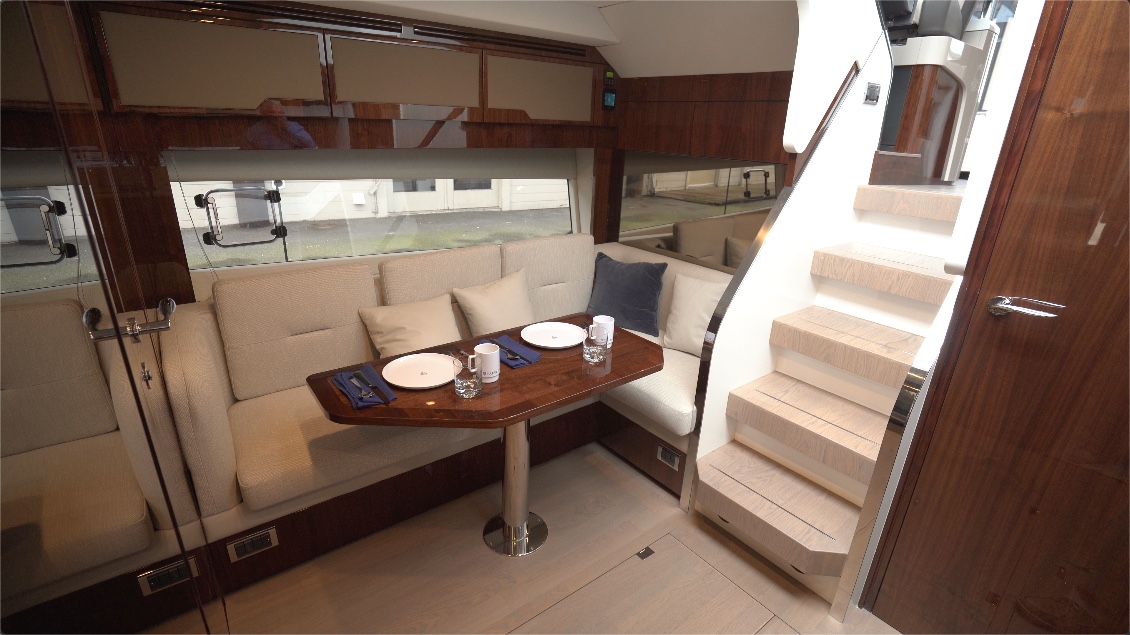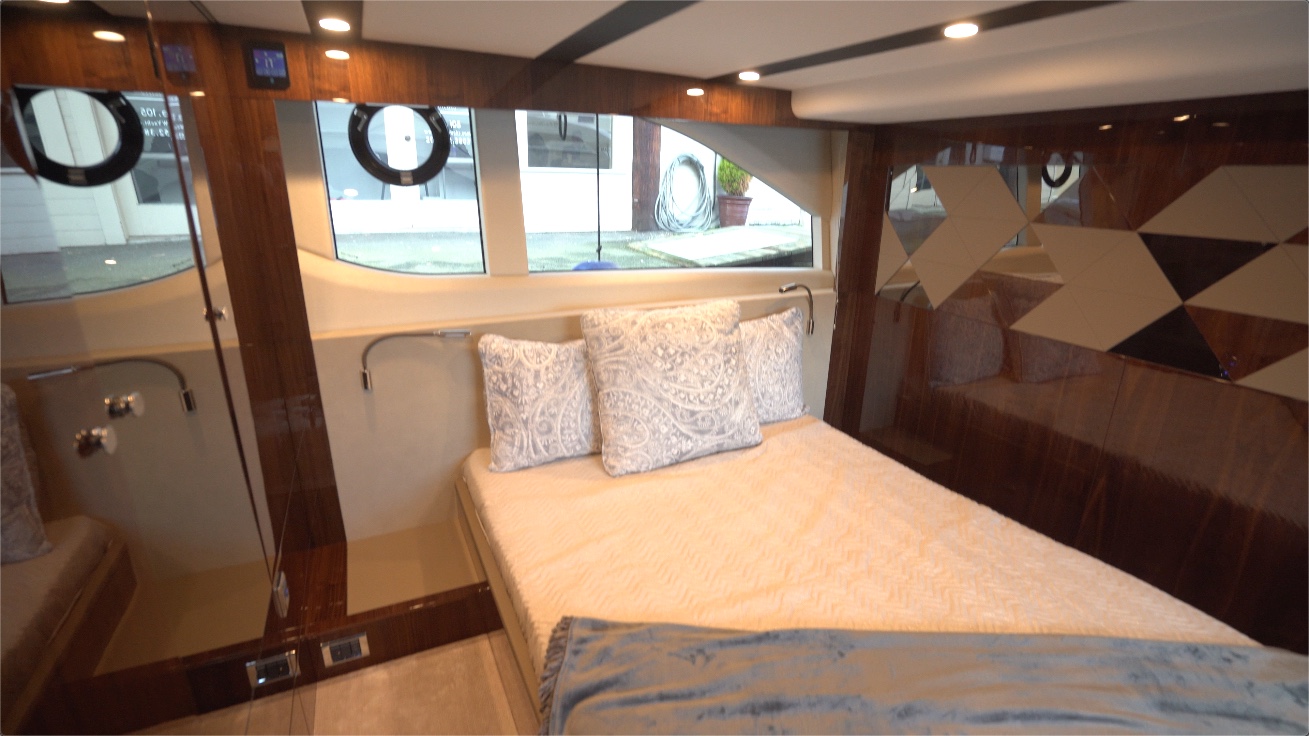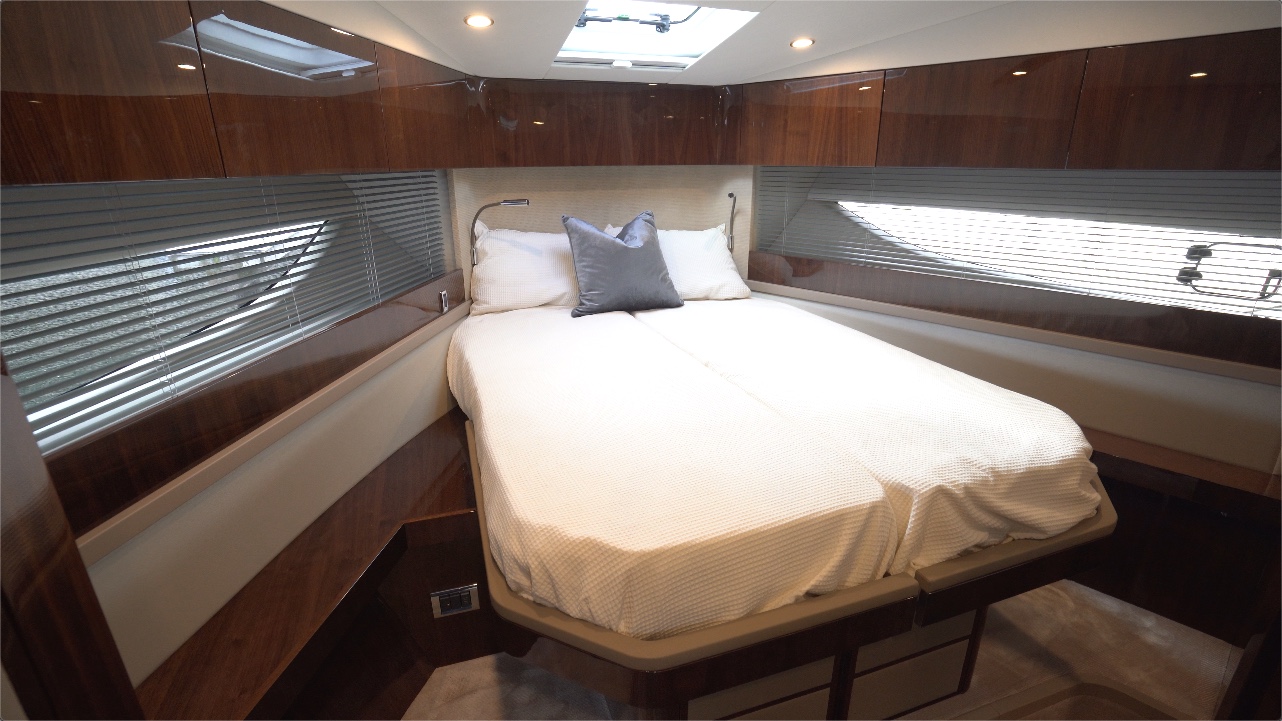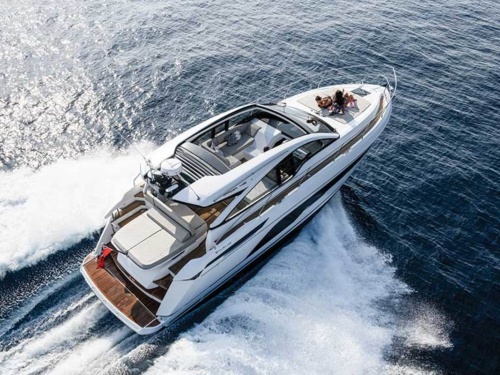Access More Boat Tests
Already have an account? Login
Fairline Targa 45 GT (2021-)
2 x 440-hp Volvo Penta IPS600 D6
Brief Summary
Fairline Yachts has had a tremendous success story with its Targa line of yachts, so much so that we would dare to say that they are iconic to the brand. The 45 Open has been among the most successful. Customer feedback has led Fairline to the conclusion that it needed to make an enclosed version. Thus, the GT was born — a sister-ship to the open version. The model we tested was the first of its kind to be delivered to North America.
Before making its trek to the states, however, she toured Europe and garnered a slew of awards along the way. It’s a collaboration of Fairline’s in-house design team and the design house of Alberto Mancini, whose fingerprints are all over the company’s 65 GT, the F//Line 33 and the 45s.
Test Results
| RPM | MPH | Knots | GPH | MPG | NMPG | STAT. MILE | NM | dBa |
|---|---|---|---|---|---|---|---|---|
| 600 | 4.6 | 4 | 4.9 | 0.9 | 0.8 | 241 | 210 | 54.2 |
| 1000 | 7.1 | 6.2 | 2.1 | 3.5 | 3 | 891 | 775.2 | 61.5 |
| 1250 | 8.4 | 7.3 | 3.4 | 2.5 | 2.1 | 632 | 549.7 | 56.6 |
| 1500 | 9.6 | 8.3 | 5.2 | 1.9 | 1.6 | 480 | 417.2 | 57.4 |
| 1750 | 10.7 | 9.3 | 7.9 | 1.4 | 1.2 | 351 | 305.1 | 64.6 |
| 2000 | 11.6 | 10.1 | 11 | 1.1 | 0.9 | 271 | 236 | 60.5 |
| 2200 | 12.4 | 10.7 | 14 | 0.9 | 0.8 | 227 | 197.4 | 63.4 |
| 2400 | 14.3 | 12.4 | 17.5 | 0.8 | 0.7 | 210 | 182.9 | 64.9 |
| 2600 | 16.8 | 14.6 | 21 | 0.8 | 0.7 | 205 | 178.5 | 67.2 |
| 2800 | 19.4 | 16.9 | 24.5 | 0.8 | 0.7 | 204 | 177.2 | 68.5 |
| 3000 | 22.4 | 19.5 | 28.5 | 0.8 | 0.7 | 202 | 175.9 | 68.9 |
| 3200 | 26.2 | 22.8 | 34 | 0.8 | 0.7 | 198 | 172.5 | 69.9 |
| 3400 | 29.3 | 25.5 | 36 | 0.8 | 0.7 | 209 | 182.2 | 73.9 |
| 3600 | 32.4 | 28.2 | 40.5 | 0.8 | 0.7 | 206 | 179.1 | 74.2 |
| 3740 | 34.6 | 30.1 | 45 | 0.8 | 0.7 | 198 | 172.1 | 74 |
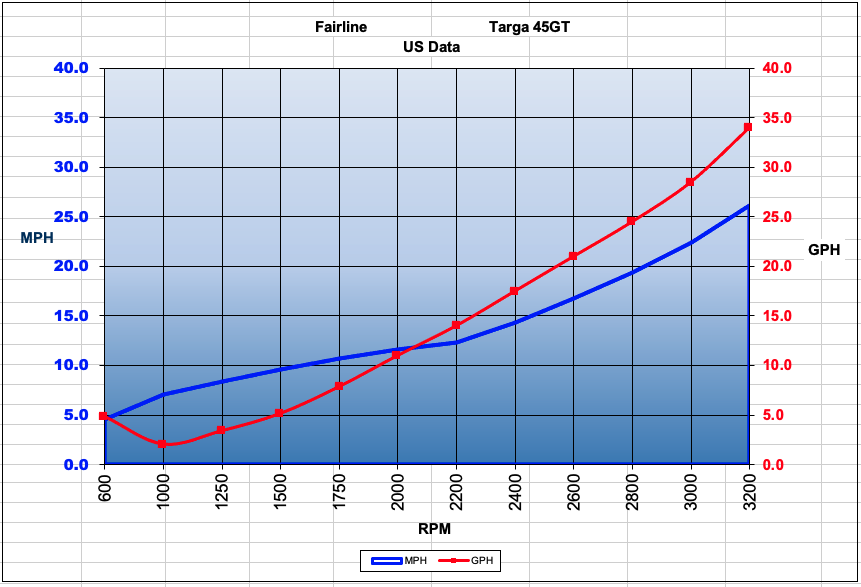
Specifications
| Length Overall |
46'6" 14.2 m |
|---|---|
| Beam |
14'2" 4.32 m |
| Dry Weight |
28,660.12 lbs. 13,000 kg |
| Tested Weight |
30,909 lbs. 14,020 kg |
| Draft |
3'10" 1.17 m |
| Bridge Clearance |
18'2" 5.55 m |
| Person Capacity | 12 |
| Fuel Capacity |
286 gallons 1,082.62 L |
| Water Capacity |
96 gallons 363.4 L |
| Total Weight |
30,909 lbs. 14,020 kg |
Acceleration Times & Conditions
| Time to Plane | 6.6 seconds |
|---|---|
| 0 to 30 | 20.1 seconds |
| Load | 4 persons; 243 gal. fuel; 50 lbs. gear |
| Climate | 60 degrees; 34 humid.; winds: 5-10; seas: <1 |
Engine Options
| Tested Engine |
2 x 440-hp Volvo Penta IPS600 D6 |
|---|---|
| Std. Power |
2 x 440-hp Volvo Penta IPS600 D6 |
| Opt. Power |
2 x 480-hp Volvo Penta IPS650 D6 |
By Capt. Steve
What exactly is a Targa?
First, let’s discuss what it takes to be considered a Targa. The moniker actually started back in the ’80s. Americans refer to it as an “express cruiser.” The concept is that of a single helm and a decidedly European design with a sporty, very contemporary profile. The lines have a laminar and smooth flow to them as the eye carries back from bow to stern. We think it has an attractive look to it from pretty much any angle. It strays from the boxy look that other yachts seem to gravitate towards. The Fairline touch adds a decidedly upscale fit-and-finish to the end product that elevates it to a “next level” yacht and adds to its allure. It’s also very much a contemporary yacht whose styling will not whither anytime soon.
Carrying on with the Fairline nomenclature, if we were to add a flying bridge to the design, the model would become a “Squadron.”
Mission
The Fairline Targa 45 GT targets the family-oriented customer that is looking to do some limited coastal cruising, perhaps weekending, to favorite marinas. Of course, entertaining onboard is certainly in the mix. It’s usually the families that have kids that haven’t quite left the nest yet and are looking to spend as much quality time as possible before those kids head off into the world. It’s also for the buyer that has come from a smaller, similar style who is looking for a little more room to spend more time aboard. It’s the buyer that wants to go boating further and in something with a nicer fit-and-finish to it. One who is “growing up” into boating.
Major Features
- Mid master or forward master
- IPS 600 or 650 power
- Tender garage
- Submersible swim platform
- Large opening sunroof
- Collaboration with Alberto Mancini
- Two or three-cabin layout
Performance
With the twin 440-hp IPS 600 engines run up to 3740 RPM, our speed topped out at 30.1 knots. Best cruise came in at 3400 RPM and 25.5 knots where the 36 GPH fuel burn produced a range of just over 182 nautical miles, all while still holding back at 10% reserve of the boat's 286-gallon (1,082.6 L) total fuel supply. She’ll reach planing speed in 6.6 seconds and hold plane down to 12.9 knots. We reached 20 mph in 7.9 seconds and 30 in 20.1 seconds.
Handling
It's a fun boat to operate. It's IPS-powered, so it has the same characteristics that we would expect from an IPS-powered boat. That is to say, she has the wide turning angles that are characteristic of pod-driven boats. We came around 180-degrees at 24 knots in 30 seconds with about 5-6 boat lengths, so not a tight turn by any standards. But I wouldn't expect it to be. Drop the speed down and then you get more swing out of the pods and then the turn tightens up a bit. She likes trim. When you get her up on plane, and I mean a solid plane, not just a minimum planing speed, start bringing in the trim to get that bow to come down. You want about a level ride. Then she'll pick up speed. It's not going to be a boost in speed that you're going to feel but if you look at your GPS, you’ll start seeing the numbers climb up slowly, so she definitely likes to be trimmed.
She’s got a comfortable turning angle without a lot of slide in the turn, so she stays comfortable. You're not going to be shoving everybody over to one side. You’re also not going to lose a lot of speed in the turns. From 24 knots, when I put it into a hard over turn, I only lost maybe .5 - .6 knots and that's about it. So she is a nice handling boat with good performance.
Engines
The engine room is accessed from two ways. The first is from a hatch on the port side of the aft sun pad. From here, there’s literally no room except for the port side of the port engine because we've got a tender garage and that's normal. I would 100% expect to see something like this. Now if we open the tender garage, the deck then lifts on an electrically actuated strut exposing the whole engine compartment and now there’s unlimited access. Much better.
The focal point is the twin IPS 600 engines at 440-HP each. We can go up to the IPS 650 at 480 horsepower. There’s a 10-kW generator and an option for putting a gyro stabilizer here, which will be a SeaKeeper 3 ($48,807).
Features Inspection
Aft Deck
The aft deck starts with J-shaped seating wrapping around a solid wood table. There’s a Corian insert in the center with beverage holders, and this is the optional expandable table ($6,759) providing a little bit more room. And notice that when it’s expanded, the center-mounted beverage holders are still exposed. Over to the starboard side is a corner-mounted piece with more Corian counter. Lift it to reveal a sink with an option for an electric grill ($3,102). Storage underneath includes a trash receptacle.
Decking in this area is all teak. The entire area is all under the protection of the extended overhead 6’6” (2.01 m) off the deck.
Just behind the seating is a large sun pad and the seatback is reversible. I'd like to see a lockable position in the aft-facing chaise lounge position but currently, it only locks into a more fully reclined position. Rails surrounding the pad would also allow it to be used when underway.
Swim Platform
Stairs to starboard lead to the swim platform. From the transom, it comes out 39” (99.06 cm), 30” (76.20 cm) of which is hydraulically actuated. I like that there's a grab rail along the trailing edge of the platform for the swimmers in the water. This one also has a capacity of 880 lbs. (399.16 kg) so we can use it to hold a PWC. Also, when the platform is lowered, there's a bit of a seat against the transom to sit and relax on, plus it makes it easier for reboarding.
Bow
As we make our way to the bow, the side decks measure 18” (45.72 cm) wide and the rails top out at 28” (71.12 cm). Two midship cleats facilitate tie-ups. At the top of the trunk cabin, there's a sun pad measuring 92” x 86” (233.68 cm x 218.44 cm) with a diamond stitch pattern. There are straps going across for holding your towels in place. The heads are in fixed positions, so I'd like to see them raise into a chaise lounge position.
Ground Tackle
The windlass is concealed under a hatch with a lift and lock latch. There’s an all-chain rode. A Lewmar windlass feeds through a chain stopper to a recessed anchor roller and then a polished stainless-steel anchor just ahead of that. There's also a receiver for a remote control.
Next to both caprails are cleats and just ahead of each are chocks. That’s not an ideal setup as the lines have to make a 90-degree angle to even use those chocks. Given that the lines will likely run straight out from the cleats, I'd like to see chafing strips added to the outside of the cleats. Rail height here is 31” (78.74 cm). Looking back at the antenna array, I notice it’s in a fixed position but there is a collapsible option, which allows for improving on the bridge clearance if need be.
Salon
Moving inside, the double sliding glass doors give us an opening 34” (86.36 cm) wide. Headroom right at the doorway is 6’ (1.83 m) and as we step in, it opens up to 6’8” (2.03 m). We can further blend the inside with the outside by opening up a window right alongside, and a gas-assist strut gives it a firm hold so there’s no need to latch it in the open position. The result is a well-lit and open main deck completely surrounded by glass.
Seating starts with a J-shaped settee to the port hand side wrapping around a high gloss Walnut finished table on a fixed pedestal, but we can also get it on a high low pedestal. Looking across to the entertainment center over on the starboard side, there's a fiberglass counter along with Corian. A TV is on an electric lift. Storage is underneath that includes a cockpit refrigerator or we can swap it out for an icemaker.
Now for temperature control, we can have tropical air conditioning ($29,688), which is reverse cycle. Fairline also took a page from the distance cruising set and offers a diesel-fired system ($18,583) for hydronic heating as well as demisting ($8,768)
For even more ventilation, there are two manually opening windows to both port and starboard along with a large sunroof overhead that opens to a full 5’9“x 9’7” (1.75 m x 2.92 m). Pull-down shades are manually operating, and that’s a welcome feature as it's just one less thing to break years down the road.
The Fairline Touch
Looking around this space, I'm already seeing many examples of the elevated level of fit-and-finish that comes from Fairline. The upholstered brow, the overhead, all upholstery… we've got fabric on the couch but this can be swapped out for leather… and I mean actual leather, not Ultraleather. The handrail at the companionway has an elevated modernized look. The settee to port has a chaise lounge effect to the forward seatback where anyone else would simply make it straight up and down. But it could be made even more functional by making it adjustable.
Helm
The helm is mounted to the port-hand side of the starboard mounted console. There's a compass directly in line with the wheel. There’s a raised panel that houses the 7” (17.78 cm) Volvo Penta display and the steering wheel on a tilt base. Electrical switches are across the top to the right-hand side and the left. There’s a Garmin depth gauge. To the right-hand side are the IPS joystick, ignitions, the digital engine controls and a 12” (30.48 cm) display.
There are two extremely comfortable bucket seats. The observer is going to be at the starboard side right next to the opening side window, so the operator has to get up to let the observer in and out.
As for visibility, the upper window frame was right in my upper sightline from the seated position when operating at idle. Not really a problem when viewing traffic though. When standing, the sunroof was right at my head height and I'm 5’8” (1.73 m) so that'll give you an idea of where you will stand. With the sunroof open, I had a sightline over the top of the upper windshield frame.
When you want to put the 45 into a turn, she leans over and this naturally creates a blind spot as the roofline comes down. This is going to be the same with any boat this style. So the point is, make sure you clear your turns by looking left and right before you initiate the turn. There’s a huge single-piece windshield and I would like to see defog vents because I have a feeling that on a rainy day, this is going to be problematic.
Below Deck
The companionway leading down below is an open, atrium-style letting plenty of light to the lower deck from the single-piece windshield and the sunroof, if opened. It’s a very appealing feature, especially with the light reflecting off the high gloss woodwork.
Galley
The galley is to port and includes Corian counters that have a grooved drying area leading to a single basin sink. The cover for the sink reverses to form a cutting surface. There's a microwave garage to the forward bulkhead. At the aft end of the counter is a double burner induction cooktop. All the doors are anti-slam/soft close. Hullside windows are to both sides and both have opening portlights.
Dining
To starboard is the dining area. It features an L-shaped settee wrapping around a Walnut table, again with beautiful finish work. It’s on a fixed pedestal but we can also get it on a high-low pedestal, allowing us to convert this into a day bed.
Again, it’s hard not to notice the elevated level of fit-and-finish that’s indicative of a Fairline. High-gloss walnut is all around. I like that there's leather upholstery in the middle of the gloss-finished cabinet doors. There’s upholstery on the overhead as well. All the doors have magnetic latches that remain recessed until the doors are softly closed, then the latches are deployed and the door remains closed. There is gasketing all the way around the doors so there’s no rattling when underway. To the forward bulkhead, there’s a full-height, smoked and frameless mirror.
Third Cabin Option
As an option, this whole dining area can be converted to another cabin with hi/lo berths. A bulkhead will be fitted with a door at the forward end. We’ll also have access to the head just forward and this head also has a separate walk-in shower.
Master Stateroom
Just aft and down three steps is the master stateroom and it’s stunning in its detail. There’s 6’7” (2.01 m) of overhead clearance, which leaves 4’2” (1.27 m) over the berth. Hullside windows are to both sides. All the drawers are soft close. Again, there’s leather upholstery inside the framed woodwork. There's more storage underneath the athwartships mounted berth.
Make yourself aware that to the side before the storage credenza, there is one step that gets us up the curve of the hull. As for options, this could be swapped out for a sofa under the window, which means you would lose the storage. I might consider going with a cushion on top of the storage instead, so we could have a nice little sitting area right in front of the window and it could possibly double as a little kid’s sleeping area.
Master Head
The master head has a private entrance. It includes a hullside window with an opening portlight. Storage is behind mirrored doors. There’s another walk-in shower and an electric flush toilet.
VIP
The VIP stateroom is located fully forward and is laid out in the typical fashion of an island berth, accessible from both sides. There are steps to both sides to ease the entry. Natural light comes from an overhead hatch and windows to both sides with opening ports. Pull-down blinds add privacy. Fairline utilized the space above the windows for storage, a factor that a lot of builders seem to neglect.
This berth can also be separated, scissor fashion, and we could also utilize this as the master stateroom. That said, the stateroom we saw as the master could then be fitted with twin berths.
Ensuite
This stateroom also has a private entrance to an ensuite, and this is the same head that we saw accessed from the salon.
Observations
Clearly, there are a lot of upscale features on this yacht so it's not for everyone. It's for the more discriminating buyer. As for the design, I can clearly see the elements of Alberto Mancini working in collaboration with the in-house design team at Fairline and it really comes together nicely. It’s an excellent combination of style, form and function.



